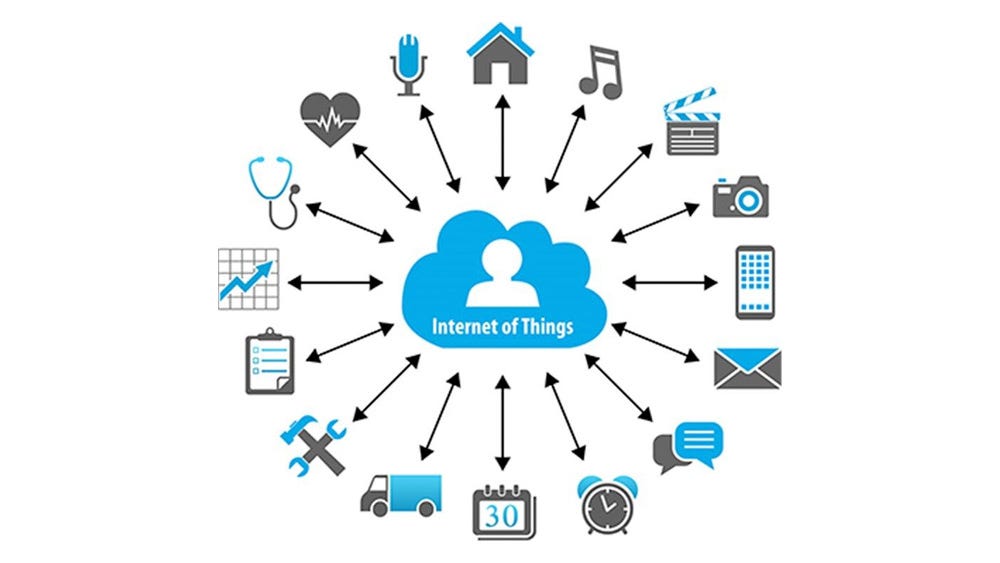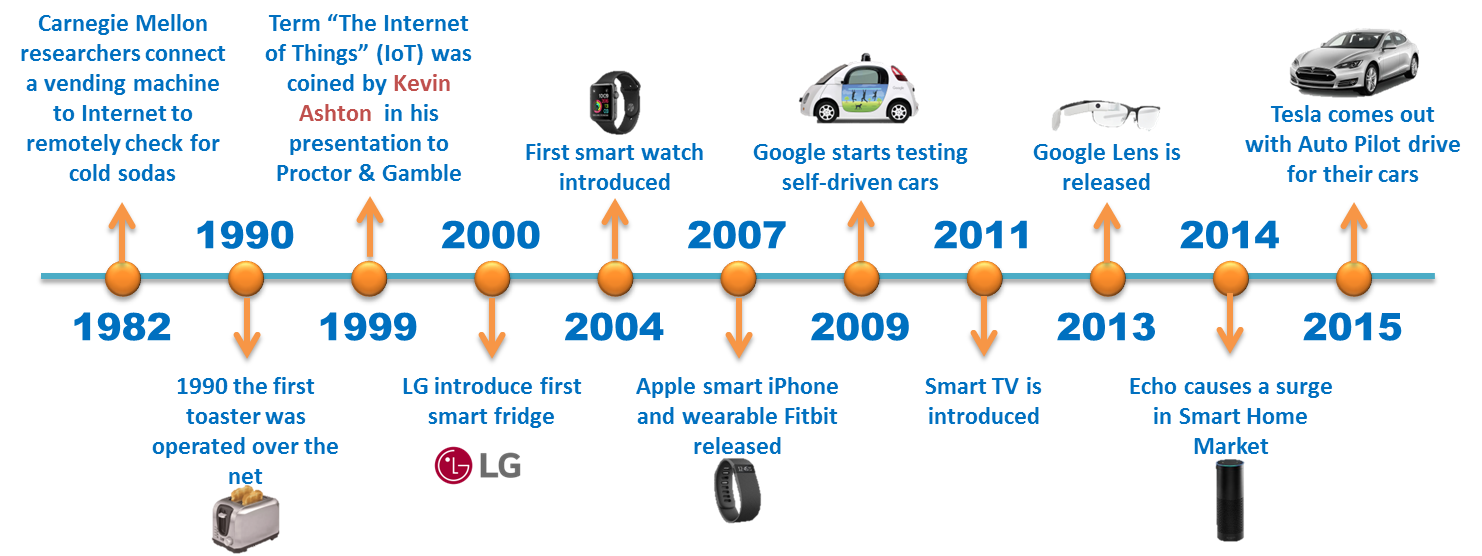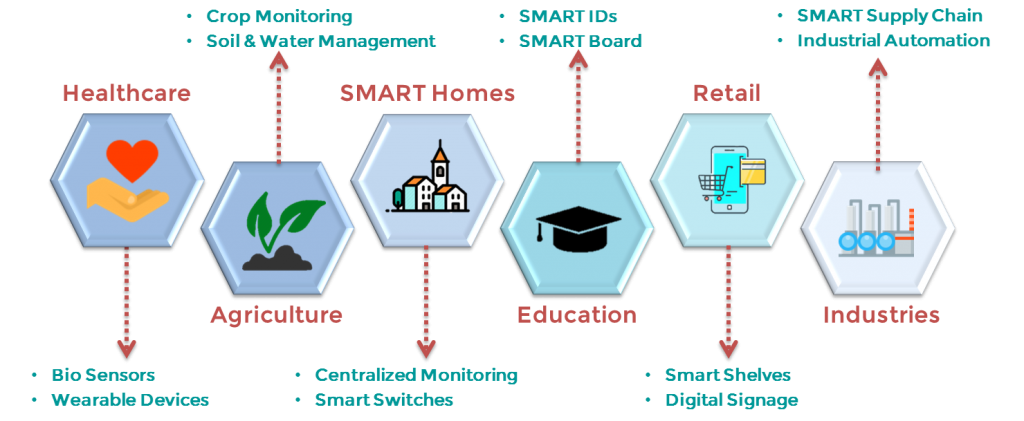01 Overview of Why IoT is so important
IoT (Internet of Things) ek network hai jismein devices aur sensors internet se connected hote hain. Yeh devices data collect karte hain aur ek doosre se communicate karte hain.
Example: Smart home devices jaise smart bulbs, smart ACs, aur CCTV cameras. IoT ka use industries, healthcare, aur automation me be hota hai.


Internet of Things (IoT) ek network hai jo physical devices ko connect karta hai. Yeh devices bina kisi human intervention ke ek doosre se data transfer kar sakte hain. IoT sirf computers ya machinery tak seemit nahi hai, balki koi bhi sensor-enabled device jo ek unique identifier (UID) rakhti hai, uska hissa ho sakti hai.
Bhale hi IoT zyada logon ke liye ek naya concept lagta ho, yeh technology pichle 20 saalon se exist karti hai.
1999 me MIT ke Kevin Ashton ne pehli baar “Internet of Things” term ka use kiya tha. Uske baad, 2000 me LG ne duniya ka pehla smart fridge launch kiya, aur 2007 me pehla iPhone aaya.
Aage ka safar itihaas hai! Smart TVs se lekar supply chains me RFID tags aur self-driving cars tak, IoT ne duniya par apna bada asar dala hai aur aage bhi iska expansion hota rahega.

Yeh timeline IoT (Internet of Things) ke development ko dikhati hai:
1982: Carnegie Mellon ke researchers ne vending machine ko internet se connect kiya taaki remotely cold sodas check kar sakein.
1990: Pehli baar ek toaster internet ke zariye operate kiya gaya.
1999: Kevin Ashton ne “Internet of Things” term introduce kiya apni Proctor & Gamble presentation me.
2000: LG ne pehla smart fridge launch kiya.
2004: Pehli smart watch introduce hui.
2007: Apple ka pehla iPhone aur wearable Fitbit launch hua.
2009: Google ne self-driving cars ka testing start kiya.
2011: Smart TV introduce hui.
2013: Google Lens release hua.
2014: Amazon Echo ne Smart Home Market me bada impact dala.
2015: Tesla ne apni cars ke liye Auto Pilot drive introduce kiya.
Yeh sab IoT ke advancements ko dikhata hai jo technology ko aur smart bana rahe hain! 🚀

Yeh image IoT Sprinkler System ka ek example dikhati hai jo smart irrigation ke liye use hota hai. Is system ka kaam yeh hai ki bina human intervention ke soil ki moisture level detect karke sprinkler ko automatically control kare.
Kaise kaam karta hai?
1️⃣ Soil Moisture Sensor:
Sensor soil ki moisture level ko detect karta hai.
Agar soil dry hai toh system ko signal bhejta hai.
2️⃣ Control Center ko Signal Bhejna:
Sensor ka data ek router ya gateway ke through Control Center (Cloud ya Local Server) tak pahunchta hai.
3️⃣ Control Center se Sprinkler ko Command:
Control Center moisture level analyze karta hai.
Agar soil dry hai, toh sprinkler ko ON karne ka command bhejta hai.
4️⃣ Sprinkler ON/OFF Hota Hai:
Sprinkler ON hoke paani supply karta hai.
Jab soil ka moisture level wapas theek ho jata hai, toh system automatically sprinkler ko OFF kar deta hai.
Kya Fayda Hai?
✅ Automatic irrigation – Manual watering ki zaroorat nahi.
✅ Paani ka conservation – Sirf zaroorat ke mutaabik paani use hota hai.
✅ Smart Monitoring – Remote se data monitor aur control kiya ja sakta hai.
Yeh ek Internet of Things (IoT) ka best example hai jo Smart Agriculture me use hota hai! 🚀
IoT Kyu Important Hai?
Behtar Faisle Lena (Better Decision Making)
Devices me multiple sensors hote hain jo alag-alag sources se data collect karte hain. Isse unke paas zyada information hoti hai jo unhe sahi decision lene me madad karti hai.
Ek best example smartphones hain. Ye tumhari activity, location aur age ke basis par tumhare behavior ko track karte hain aur tumhe suggestions dete hain.
Phone tumhari screen time, power consumption aur sleeping patterns ko bhi track karta hai. Roz bahut sara data collect hoke smartphone companies ko bheja jata hai taki wo apne devices ko aur improve kar sakein.
Big data ke continuous flow ki wajah se companies ko pata chal jata hai ki users unke devices ka kaise use kar rahe hain. Isse unhe apni strengths aur weaknesses ka bhi pata chalta hai.
Ye insights sirf tab possible hoti hain jab embedded sensors aur processors data ko analyze karte hain.
IoT Ka Example: Smart Homes
Ek smart home system ek perfect example hai jo IoT ka use karta hai better decision making ke liye.
Kaise Kaam Karta Hai?
Smart Thermostat (Nest, Ecobee) – Ye sensors use karta hai aur tumhari temperature preferences aur daily routine ko track karke automatically AC ya heater adjust kar deta hai. Isse energy bhi save hoti hai aur convenience bhi milti hai.
Smart Lights (Philips Hue, Wipro) – Ye motion sensors aur time scheduling ke basis pe apne aap lights on/off kar sakti hain. Agar room me koi nahi hai, to lights band ho jayengi, jo electricity save karega.
Smart Security Cameras & Doorbells (Ring, Arlo) – Ye motion detect karke real-time alerts bhejti hain aur agar koi ajnabi darwaze ke pass aaye to tumhe notify kar deti hain.
Kya Fayda Hua?
✅ Energy Efficiency – IoT devices usage pattern samajh ke power save karte hain.
✅ Security & Safety – Smart locks aur cameras real-time monitoring dete hain.
✅ Convenience – Tumhe manually kuch adjust karne ki zaroorat nahi, sab kuch automated hai.
Conclusion: Smart home devices data analyze karke better decisions lete hain, jo na sirf life easy banate hain balki resources bhi save karte hain. 🚀
Real-Time Tracking Aur Monitoring
Web-based tracking aur monitoring systems ka bahut bada scope hai. IoT tracking ki madad se vehicles, chori hua samaan ya shipping containers ko easily track aur monitor kiya ja sakta hai.
Kuch special devices environment me hone wale changes bhi detect kar sakti hain. Bahut saari industries me IoT trackers ka use karke companies ki efficiency badhayi ja sakti hai. Agar in devices me koi fault aa jaye, to company ko bada nuksan ho sakta hai.
IoT-based trackers ka reliable hona zaroori hai, taki wo best service de sakein.
In devices me ye important features hone chahiye:

REAL-TIME TRACKING AUR MONITORING
🔹 Real-time data analytics
Industry me fast aur accurate data chahiye taaki jab assets ya environment me changes monitor ho rahe ho, toh quick aur informed decisions liye ja sakein.
🔹 Secure communication
Companies aksar high-value assets ko track aur monitor karti hain. Isliye yeh zaroori hai ki shared data secure ho aur hackers ke threat me na ho.
🔹 Stable connectivity
Device ko securely asset location, machine functionality, aur temperatures ki useful information provide karni chahiye. Yeh har waqt aur duniya ke kisi bhi kone se possible hona chahiye.
AUTOMATION
🔹 IoT banane ka ek bada reason aasani hai.
Smart devices jo daily kaam automatically karte hain, unse log doosre kaam kar sakte hain.
🔹 Ye devices logon ka kaam halka kar deti hain.
🔹 Smartphones se hum duniya bhar ke logon se baat kar sakte hain.
Hum messages schedule kar sakte hain aur bina type kiye bolkar likh sakte hain.
🔹 Smart fridge ka example lo:
Yeh bata sakta hai ki koi food kharab hone wala hai aur owner ko yaad dila sakta hai.
Agar milk khatam hone wala ho, toh yeh automatically naya order bhi kar sakta hai.
🔹 Self-driving car ek aur accha example hai:
Yeh Internet se jud kar sabse jaldi pahunchne wala rasta dhundh sakti hai, jo logon ke liye bohot aasaan hai.
🔹 IoT me naye naye tareeke banane ki bohot sambhavnayein hain! 🚀
ZYADA EFFICIENT PERSONAL AUR BUSINESS TASKS
🔹 Web-based devices paise aur samay bachate hain.
Ye kaam ka schedule banane, time track karne, communication better banane aur daily tasks ke reminders set karne me madad karte hain.
🔹 IoT devices kaam ko aur aasaan bana dete hain:
Ye tumhare liye cheezein track aur order kar sakte hain.
Room se nikalte hi lights automatically off ho sakti hain.
Aise kaam sambhal sakte hain jo tumhare paas karne ka time nahi hai.
🔹 Agle kuch saalon me aur zyada aise devices available honge.
2024 tak, lagbhag 27 billion IoT connections hone ka estimate hai.
🔹 Technology ke aane se human productivity bhi badh gayi hai.
Aaj log pehle se zyada busy hain, aur IoT unke kaam ko aur aasaan bana raha hai.
Sabse acchi baat yeh hai ki hum apni family ke saath waqt bita sakte hain jabki IoT devices chhoti-moti activities handle kar leti hain. 🚀
IoT ka scope kaafi badh raha hai, aur alag-alag technologies ek-dusre se compete kar rahi hain. Jab hum in devices ko connect karte hain, toh compatibility ka issue aata hai. Is wajah se naya hardware aur software deploy karna padta hai.
Compatibility Issues:
🔹 Cloud Services – Alag-alag cloud platforms standardized nahi hain, is wajah se compatibility ka issue hota hai.
🔹 M2M (Machine-to-Machine) Protocols – Common communication protocol ka lack hone ki wajah se devices ek-dusre se smoothly communicate nahi kar pate.
🔹 Firmware & OS Differences – Har IoT device ka alag firmware aur operating system hota hai, jo compatibility problems create karta hai.
💡 Future Concern:
Kuch technologies future me obsolete ho sakti hain. Problem yeh hai ki traditional computing devices (like PCs) jaldi replace ho jate hain, lekin IoT appliances jaise smart fridges ya TVs kaafi saalon tak use hote hain. Agar unka manufacturer band ho jaye, toh bhi woh kaam karna chahiye, warna users ko bada loss ho sakta hai.
APPLICATIONS OF IOT
Healthcare: IoT ka use bio sensors aur wearable devices me hota hai jo heart rate, blood pressure monitor karte hain aur doctors ko automatically alert bhejte hain.
Agriculture: IoT drones ka use crop monitoring ke liye hota hai. Moisture aur soil sensors paani bachane aur soil balance maintain karne me madad karte hain.
Smart Homes & Buildings: IoT ka use ghar aur buildings ko SMART banane ke liye hota hai. Centralized Light control, Camera surveillance, Sound detection, SMART switches aur locks security badhate hain. Yeh sab resources ko efficiently manage karne me madad karta hai aur manpower ki zaroorat kam hoti hai.
Education: Smart ID cards automatically attendance record karte hain jab student school ya bus me enter/exit karta hai aur parents ko alerts bhejte hain. Smart boards teachers ko content display karne aur internet surf karne ki suvidha dete hain. Board par likha homework aur notes automatically parents ko mail hota hai.
Retail: Smart Shelves me digital price labeling hoti hai jo shelves ke halka hone par automatic notification bhejti hai. Digital signage se personalized aur interactive shopping experience provide kiya jata hai.
Industries: IoT ka use SMART supply chain management ke liye hota hai jo inventory management ko behtar banata hai. Industrial automation productivity efficiency aur flexibility badhane me madad karta hai.

Ye image IoT ke alag-alag applications ko dikhata hai, jo 6 major fields me divided hai:
1. Healthcare 🏥
Bio Sensors aur Wearable Devices ka use kiya jata hai patient ki health monitor karne ke liye.
Yeh heart rate, blood pressure track karte hain aur emergency me doctors ko alert bhejte hain.
2. Agriculture 🌱
Crop Monitoring drones aur IoT sensors ke through hota hai jo farming ko automate karta hai.
Soil & Water Management sensors se moisture level aur nutrient balance maintain kiya jata hai.
3. SMART Homes 🏡
Centralized Monitoring ka use ghar ke lights, security cameras aur devices ko ek jagah se control karne ke liye hota hai.
Smart Switches aur locks security aur convenience badhate hain.
4. Education 🎓
SMART IDs students ki attendance automatically track karte hain.
SMART Board teachers ko better teaching tools provide karta hai, jaise digital content display aur interactive learning.
5. Retail 🛒
Smart Shelves digital pricing aur automatic inventory alerts generate karte hain.
Digital Signage personalized aur interactive shopping experience provide karta hai.
6. Industries 🏭
SMART Supply Chain se inventory aur logistics ka real-time monitoring hota hai.
Industrial Automation machines aur processes ko optimize karta hai productivity aur efficiency badhane ke liye.
👉 Ye sare IoT applications life aur business processes ko smarter aur efficient banane me help karte hain. 🚀
